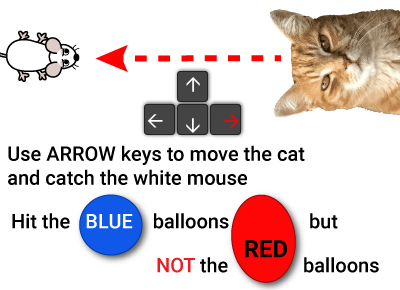


3 scores max per player; No foul language, show respect for other players, etc.
Name | Score | Date | ||
|---|---|---|---|---|
| 1 | ||||
| 2 | ||||
| 3 | ||||
| 4 | ||||
| 5 | ||||
| 6 | ||||
| 7 | ||||
| 8 | ||||
| 9 | ||||
| 10 |

Game: CAT AND MOUSE
Aim: Catch the white mice
Method:
Move the cat with the arrow keys or by tapping in the game area to catch the white mouse. Avoid the red balloons but hit the blue balloons.
Your final score is based on all of that plus number of questions answered right, and the time taken.

HI
"Standard units: symbols to names"
The CAT AND MOUSE game to practice
'Grouped frequency table: modal group, range' for 8th grade
8th grade / Statistics / Continuous data / Continuous grouped data / Grouped frequency table: modal group, range
Grouped frequency tables: modal group, largest range
Continuous data can be represented in a "Grouped frequency table" where each class (group) covers the data points within a certain range, and the classes together cover the entire range of the data.
The benefit of grouped frequency tables becomes clear when there are so many raw data points that discrete values would become difficult to process. A limitation of continuous data is that individual data points are lost so that exact calculations of the mode or range of the original discrete data points becomes impossible. Instead techniques have been developed to approximate these values for continuous data.
Instead of a mode (the most frequent individual value in a data set), we can find the "modal group" which is the class of data that has the highest frequency. So if we have a grouped frequency table with classes 1-20, 21-40 and 41-60 that have frequencies of 12, 7 and 5 respectively, then the modal group is 1-20 because it has the highest frequency of 12.
Instead of an absolute value for the range of a data set, we can find the "largest range". This is the difference between the largest possible value in the biggest class and the smallest value in the smallest class. So if our grouped frequency table has classes 21-40, 41-60 and 61-80, then the largest range is 80 minus 21 which is 59.
In this topic you are asked to find either the modal group or the largest range for a series of grouped frequency tables. There are 8 question/answer pairs in the lessons, and an additional 8 question/answer pairs in all the games and tests.
With our Cat and mouse math game you will be practicing the topic "Grouped frequency table: modal group, range" from 8th grade / Statistics / Continuous data / Continuous data. The math in this game consists of 16 questions that ask you to identify the modal group or largest range for each grouped frequency table.

Cat versus mouse game with added balloons for math and fun. You are the ginger cat, and your life is being made a misery by some white mice which have come into the house and are proving hard to catch. Not to mention there is a mouse house party going on and lots of balloons getting in the way of your hunting.
So you have to catch the white mice, forget about the gray mice, hit the blue balloons but avoid the red balloons, and answer math questions (you are a CLEVER cat...). If it sounds complicated and a bit frantic, that's because it is. Do your best but don't worry if you can't catch all the mice - neither can we. It's a cat's life...
UXO * Duck shoot * The frog flies * Pong * Cat and mouse * The beetle and the bee
Rock fall * Four in a row * Sow grow * Choose or lose * Mix and match

Latest leaderboard entries: Cat and mouse




How to play CAT AND MOUSE to practice
'Grouped frequency table: modal group, range' for 8th grade

CAT AND MOUSE is a quirky take on the perennial enmity of ponderous predator and plucky prey. Here are the basics:
- Press "PLAY" on the CAT AND MOUSE settings page to open the game.
- You are a ginger cat overwhelmed by a serious mouse problem.
- Luckily your job is only to catch the white mice, not all the mice.
- Trouble is, they are not easy to catch and will try to avoid you.
- Use the arrow keys or tap the screen in the direction you want the cat to go.
- You will need fast reaction times to catch those white mice, and the balloons keep getting in the way.
- Mouse scores are 25 points for each white mouse caught, minus 5 points for each white mouse that escapes.
- When you do catch a white mouse, a math question will appear.
- Answer the math question correctly for those extra points...
- You get 50 points for each correct answer, but you lose 25 points for each wrong answer.
- Hitting blue balloons gives you extra points, but 3 hits on a balloon will burst it for that level.
- Hitting red balloons takes away points.
- Balloon scores are +5 or +10 points for blue balloons, -5 or -10 points for red balloons.
- This is a timed game and your final score is calculated by taking away your time in seconds from the points you have earned.
- If you get one of the 10 best scores you can add your name to the leaderboard for your chosen topic.



















